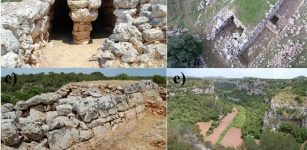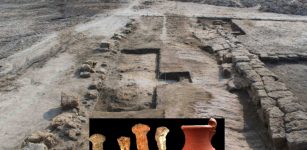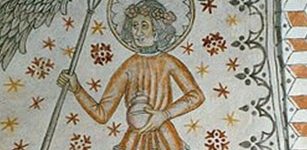Kingdom Of The Vandals: A People In Search Of A Home
David Tee - AncientPages.com - The name may bring fear to many, as this ancient society is forever linked with those who cause destruction to property - vandals, and vandalism. Yet they may not have been as fierce or destructive as their modern namesakes.
Left: Genseric, leader of the Vandlas in North Africa. Credit: Janboruta, Public Domain - Right:Reconstruction of an Iron Age warrior's garments representing a Vandalic man, with his hair in a "Suebian knot" on display at Archaeological Museum of Kraków, Poland. Credit: Public Domain, CC BY-SA 3.0
Trying to find the origin of the original Vandal people is difficult. Historical records state the tribe appeared first inhabiting present-day southern Poland. Some historians have found the name in central Sweden, in the parish of Vendel. Plus, the name has cropped up in Denmark and Norway with possible ties to a Norwegian royal family.
Wherever they came from, it seems that the people were in search of a home.
First Roman Contact With The Vandals
The Vandals seem to have been in contact with Rome early on and when the Roman Empire was at its height. Cassius wrote that the Vandals were led by Raus and Raptus and after a battle they made peace in exchange for some land.
The Sack of Rome, Karl Briullov, 1833–1836. Credit: Public Domain
For some reason, and it could possibly be that the Vandals had no permanent home, they made little impact on the archaeological record. They also appeared very briefly in historical records.
But they were able to defeat the Romans in Spain in the early 5th century and were even allies of Rome at one time as Stilicho, a Roman general, who was of Vandal origin. The 5th century was one of struggle for the Vandals as they fought the Franks, the Huns, The Romans and the Visigoths.
The Vandals In Spain And Beyond
The battle victory against the Romans in Spain was due to two factors. First, the Visigoths decided to not honor their allied agreement with the Romans. Their departure left the Romans militarily weak.
Then, second, The Roman general Castinus changed strategies and decided to attack the Vandals instead of starving them into surrender. After the defeat of the Romans, the Vandals were able to broaden their conquest of Spain and captured the city of Seville after two attempts.
For some reason, Spain was not to be the Vandals' home. Their new leader, Genseric, decided that North Africa was the place for the Vandals to migrate to and conquer. The exact number of Vandals who went to North Africa is unknown, and some historians discount the 80,000 number.
The Vandals In North Africa
The reason that the Vandals went to North Africa is unclear as well. Some historians claim that they went at the invitation of Bonifacius, while others claim it was done in search of safety.
Migrations of the Vandals from Scandinavia through Dacia, Gaul, Iberia, and into North Africa. Grey: Roman Empire. Credit: Public Domain
Whatever the reason, the Vandals decided that Hippo would be their first capital. They laid siege to that city even though St. Augustine was living there at the time. It took the Vandals 14 months to bring the city to its knees.
The Vandals in 435 AD, finally made a treaty with the Romans and the latter gave them large amounts of territory as their own. But for Genseric, the territory was not enough, and he broke the treaty in 49 AD, by attacking and conquering Carthage.
Carthage became the new Vandal capital, and from their Genseric, who ruled for 50 years, conquered Sicily, Malta, Sardinia, Corsica, and other islands. From their wandering beginnings, the Vandals may have finally found their home.
The Vandals And Rome Were Not Finished
Genseric used his new home to raid and conquer other parts of the Roman empire. Unfortunately, the Romans were battling the Gauls at the time and Attila the Hun, so they could not address their empire's reduction at the Vandals' hands.
The Romans tried to regain their territory, but that peace effort was undone by Valentinian III's assassination. Genseric did not like what took place and attacked Rome. It is said that Pope Leo I had Genseric agree not to kill or burn but simply plunder.
This was done, and it is said that he took the treasures from the Temple of Jerusalem back to Carthage with him.
The Vandal End
After Genseric died, a few weak rulers came to the Vandal throne, but those rules were unstable due to infighting and other intrigues. This situation left the Vandals weak and ripe for conquest.
It was the Byzantines who finally put an end to the Vandal Empire and civilization.
Updated on April 18, 2024
Written by – David Tee AncientPages.com
Copyright © AncientPages.com All rights reserved. This material may not be published, broadcast, rewritten or redistributed in whole or part without the express written permission of AncientPages.com
Expand for referencesMore From Ancient Pages
-
 Eating And Social Habits Of People In The Balearic Islands 3,000 Years Ago – Reconstructed
Archaeology | Jan 18, 2023
Eating And Social Habits Of People In The Balearic Islands 3,000 Years Ago – Reconstructed
Archaeology | Jan 18, 2023 -
 Lost Q Source Remains An Unsolved Biblical Mystery
Biblical Mysteries | May 7, 2017
Lost Q Source Remains An Unsolved Biblical Mystery
Biblical Mysteries | May 7, 2017 -
 Mystery Of The Ancient Okunev Culture: Skeleton Of 4,500-Year-Old Noblewoman With Links To Native Americans Discovered In Siberia
Archaeology | Sep 9, 2016
Mystery Of The Ancient Okunev Culture: Skeleton Of 4,500-Year-Old Noblewoman With Links To Native Americans Discovered In Siberia
Archaeology | Sep 9, 2016 -
 Australia’s First Marine Aboriginal Archaeological Site Questioned
Archaeology | Jun 22, 2022
Australia’s First Marine Aboriginal Archaeological Site Questioned
Archaeology | Jun 22, 2022 -
 On This Day In History: Cliff Palace At Mesa Verde, Colorado Discovered – On Dec 18, 1888
News | Dec 18, 2016
On This Day In History: Cliff Palace At Mesa Verde, Colorado Discovered – On Dec 18, 1888
News | Dec 18, 2016 -
 Mysterious Ancient Human Skeletons Found In Florida Lake Puzzle Archaeologists – Unknown Lost Settlement?
Featured Stories | May 21, 2024
Mysterious Ancient Human Skeletons Found In Florida Lake Puzzle Archaeologists – Unknown Lost Settlement?
Featured Stories | May 21, 2024 -
 Origin Of The Genetic Code – Study
DNA | Dec 16, 2024
Origin Of The Genetic Code – Study
DNA | Dec 16, 2024 -
 Why Was The Face Of Mysterious Ust-Taseyevsky Stone Idol Suddenly Changed?
Archaeology | Jan 18, 2021
Why Was The Face Of Mysterious Ust-Taseyevsky Stone Idol Suddenly Changed?
Archaeology | Jan 18, 2021 -
 Mysterious Bronze Age Face Carved In Rock And Rare Artifacts Found In Kazakhstan
Archaeology | Aug 12, 2024
Mysterious Bronze Age Face Carved In Rock And Rare Artifacts Found In Kazakhstan
Archaeology | Aug 12, 2024 -
 Ptolemaic Workshop For Repairing And Construction Of Boats Unearthed In Sinai
Archaeology | Feb 21, 2019
Ptolemaic Workshop For Repairing And Construction Of Boats Unearthed In Sinai
Archaeology | Feb 21, 2019 -
 Ancient City Of Metropolis: Ruins With Traces Of The Hittites, Hellenistic, Roman, Byzantine And Ottoman Empires
Archaeology | Jan 8, 2018
Ancient City Of Metropolis: Ruins With Traces Of The Hittites, Hellenistic, Roman, Byzantine And Ottoman Empires
Archaeology | Jan 8, 2018 -
 Ancient Stepwells Of India: Symbol Of Sacred Water And Boundary Between Heaven And Earth
Civilizations | Jan 11, 2019
Ancient Stepwells Of India: Symbol Of Sacred Water And Boundary Between Heaven And Earth
Civilizations | Jan 11, 2019 -
 Very Rare Ancient Roman Horse Brooch Discovered In UK
Archaeology | Mar 7, 2020
Very Rare Ancient Roman Horse Brooch Discovered In UK
Archaeology | Mar 7, 2020 -
 On This Day In History: Canute Lavard Was Murdered By His Cousin, Magnus I Of Sweden – On Jan 7, 1131
Historical Figures | Jan 7, 2017
On This Day In History: Canute Lavard Was Murdered By His Cousin, Magnus I Of Sweden – On Jan 7, 1131
Historical Figures | Jan 7, 2017 -
 Death And Afterlife In Sumerian Beliefs
Featured Stories | Aug 7, 2025
Death And Afterlife In Sumerian Beliefs
Featured Stories | Aug 7, 2025 -
 Mysterious Denny – 90,000-Year-Old Child Whose Parents Were Two Different Human Species
Featured Stories | Jul 25, 2023
Mysterious Denny – 90,000-Year-Old Child Whose Parents Were Two Different Human Species
Featured Stories | Jul 25, 2023 -
 Traces Of Ancient Near East Civilization In America – An Out-Of-Place Ancient Inscription – Part 2
Ancient Mysteries | Nov 13, 2020
Traces Of Ancient Near East Civilization In America – An Out-Of-Place Ancient Inscription – Part 2
Ancient Mysteries | Nov 13, 2020 -
 Dozens Of Unique 2,500-Year-Old Ceremonial Treasures Discovered In A Drained Peat Bog
Archaeology | Jan 27, 2023
Dozens Of Unique 2,500-Year-Old Ceremonial Treasures Discovered In A Drained Peat Bog
Archaeology | Jan 27, 2023 -
 Ground-Breaking Discovery: A 3,300-Year-Old Deep-Sea Canaanite Shipwreck Found
Underwater Discoveries | Jul 3, 2024
Ground-Breaking Discovery: A 3,300-Year-Old Deep-Sea Canaanite Shipwreck Found
Underwater Discoveries | Jul 3, 2024 -
 Mysterious 3,000-Year-Old Underwater Urartu Castle Discovered
Archaeology | Nov 22, 2017
Mysterious 3,000-Year-Old Underwater Urartu Castle Discovered
Archaeology | Nov 22, 2017



